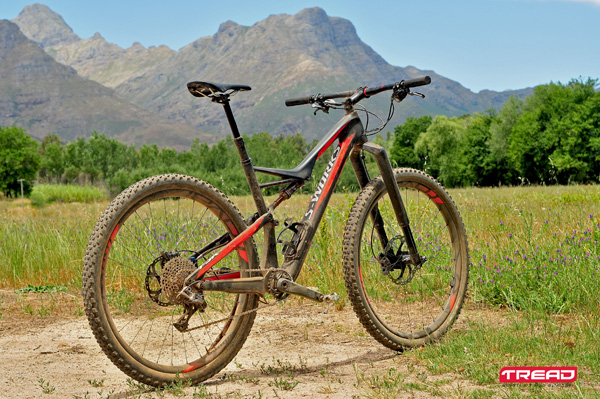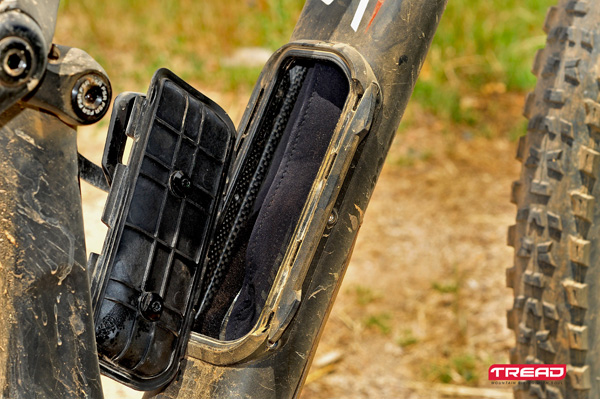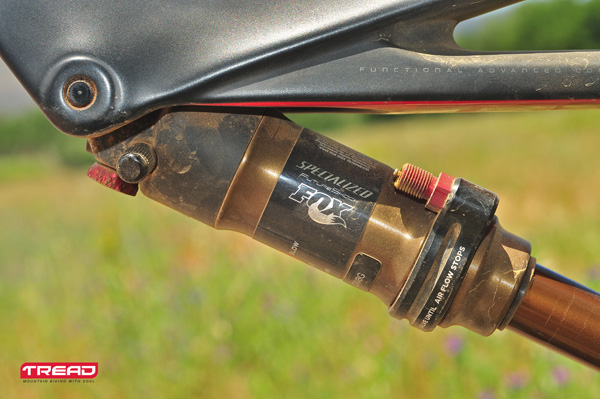Back in Issue 12 (May 2011), we tested one of the very first Camber 29ers. It was a late-comer to the Specialized stable, designed to bridge the gap between the Epic and the Stumpjumper in terms of travel, geometry and riding style. Late-comer it might be, but that’s not held it back from becoming probably the most important model in the Specialized bouquet.
By the TREAD testers
Photos: Dino Lloyd

THE BIKE
A new frame design sees a carbon front-end ‘trail chassis’ that’s used on both the Camber and the bigger-travel 2016 Stumpjumper. This redesign has also resulted in a shorter rear-end (437mm chainstays), slacker geometry (68.5-degree headtube), lower bottom bracket (330mm) and more suspension travel (120mm). The FACT carbon fibre front end gets an M5 aluminum FSR rear end, which Specialized says offers a “perfect blend of responsiveness, lightweight, and durability.”
Specialized teamed up with Fox to develop a new, Position Sensitive Mini-Brain shock specifically for the Camber. The evolved Brain shock includes an all-new internal spike valve for opening up oil flow at the correct time. The Brain does not engage until its sag point is at 25 percent of travel, set by the unique ‘auto-sag’ a valve on the shock itself. It’s a whole lot of smart engineering on a proprietary Specialized system, which goes some way to explaining the cost of this model. Fear not though regular people (like us), there are six models of Camber, the bottom of the range selling at R25999.
There’s also the SWAT storage space in the downtube, which can accommodate a tube, tools, a light rain jacket and a (smaller) phone. It may seem gimmicky, but damn it’s impressive use of space and exceptionally practical. Specialized has also finished it off really well so that it’s got a fully integrated look and feel.
Also new is a micro-adjustable remote-managed Command dropper post, which has 125mm of total movement and wider 30mm internal-width Roval Traverse carbon rims. On the S-Works model is a RockShox RS 1 Solo Air fork with 120mm of remote-adjustable travel. SRAM’s XX1 1×11 drivetrain and Shimano’s XTR hydraulic disc complete a top-end combination on a bike that looks both fast and like it can take on just about anything. The internal cabling make for a very neat finish and there’s one bottle cage, an issue for some perhaps, but when you start moving into trail bike territory, its not that unusual.
Another feature that’s noteworthy is that you get 160mm/180mm rear/front brake rotor combo on the Small and Medium models and a 180mm/200mm combo on the Large and Extra-Large models. Makes complete sense really. When you have greater braking confidence, you have greater riding confidence and tend to take more risks.

THE RIDE
We’ve been harping on for years (since we tested the first Camber in early 2011 actually) that most South Africans should be tackling marathons and stage races on models like the Camber, which offers more travel and more comfy, better-handling geometry for descents that what you get on an Epic or similar race-styled models. Yes, there’s a weight penalty to be considered, but as we’ve always maintained, mountain biking performance for the majority isn’t only a weight issue. But the new S-Works Camber, which weighs an impressive 11.62kg (with pedals) goes a way towards eliminating some weight (the 2015 S-Works Evo Camber we tested in 2014 weighed 12.5kg. That’s quite a drop…
And that lower weight is always most noticeable on climbs. And climbing we certainly did. In addition to a day of riding on some lower-slope trails around Stellenbosch, we also completed the two-day Origin of Trails event on it. The climbs were long, steep, tight, technical – pretty much every type of climb you can get. With a 28-tooth ring up front and a 10-42 cluster out back, we had absolutely no negative experiences on any of the ascents. Well we did, but they were just a result of poor rider conditioning… Quite simply, the Camber climbed superbly.
Descents were where we really got to feel the stability of the Camber. Fast, blown-out, twisty, descending singletrack saw us push our own limits often. The Camber, however, was steadfast. It tracked beautifully (there’s a 750mm bar) through turns, which is no doubt assisted by the wider rims, which change the shape of the tyres, making them less ‘bulbous’ (for want of a better word), placing more tread on the trail.
Really steep, rough descents weren’t much bother for the Camber. With 120mm of travel at both ends and a dropper seatpost, there’s very little that can disrupt you. And here’s where we feel most mountain bike marathon and stage racers will see the full benefits of a Camber – or any mid-travel trail bike for that matter.
By being in a position of greater control, as that which the Camber offers, you’re less nervous when the descents steepen. The amount of stress gained and time lost by many on intimidating descents is significant. Until you ride a different bike, a bike better designed to manage descents with more stability, you’ll never really know what’s possible.
And the Mini-Brain? Well, we love that it only responds to forces from above once 25% of the sag has been reached. This allowed us to preload it for bunny-hops, jumps and drop downs, something we’ve always struggled with when on a Brain-fitted Specialized.
That familiar mild ‘clunk’ sound/feel when you hit the first bump is also now hardly noticeable and obviously a good thing as it can be off-putting if you’re not accustomed to it.

THE VERDICT
The new S-Works Camber is a trail bike for those that like to race. ‘Quiver-killer is used a lot these days in marketing speak, but we reckon it’s a description that fits the Camber perfectly. Unless you’re a podium-finisher at races, or are super-picky on weight, as well as super-skilled, you’ll struggle to find a more versatile bike.
We wouldn’t hesitate to race marathons and stage races on it, but would also be just as comfortable entering it into an Enduro, or riding some new trails on it for the best part of a day. But it actually begs to be ridden fast. It’s designed for high performance in every aspect. And not doing so seems like an injustice.
If the price is beyond your reach, look further down the range – the basic model, which has a more standard rear shock system, sells for R25999. But first ride one. Retailers generally run a Specialized Test the Best programme, which gives everyone a chance to try the range on an available demo before making a buying decision.

GEOMETRY
SIZES: S, M, L (tested), XL
TOP TUBE LENGTH: 613mm
SEAT TUBE LENGTH: 468mm
HEAD TUBE ANGLE: 68.5 degrees
SEAT TUBE ANGLE: 75.0 degrees
CHAINSTAY LENGTH: 437mm
WHEELBASE: 1160mm
SPECS
PRICE: R139 999
COLOURS: Satin Gloss Carbon/Rocket Red
FRAME: Specialized Fact Carbon front triangle with M-Series alloy rear triangle
WEIGHT: 11.6Kg (incl pedals)
FORK: RockShox RS 1 Solo Air, 120mm with remote lockout
SHOCK: Fox/Specialized Mini Brain with auto sag and 120mm of travel (Kashima coated)
SHIFTERS: SRAM XX1
FRONT DERAILLER: N/A
REAR DERAILLER: SRAM XX1 1×11 10-42T
CRANKSET: SRAM XX Carbon (28T)
BRAKESET: Shimano XTR, Ice-Tech Rotors (180/200mm)
WHEELS: Roval Traverse SL 2428h with DT Swiss Revolution spokes
TYRES: Specialized Purgatory Control 29×2.3 (front); Specialized Ground Control 29×2.3 (rear)
OTHERS: Specialized Command Post micro-adjust height adjustable Dropper Seatpost, Specialized FACT carbon, 8-degree backsweep, 6-degree upsweep, 10mm rise, 750mm, 31.8mm Handlebars, Syntace F109 6-degree rise Stem (70mm), Body Geometry Henge Expert, hollow Ti rails Saddle, 1-1/8’’ Campy style Headset
CONTACT: www.specialized.com
XC-MARATHON-TRAIL-FREERIDE
RECREATIONAL-COMMITTED-PERFORMANCE
SPECIALIZED SAYS; POSITION SENSITIVE MINI BRAIN REAR SHOCK
When it comes to blending sheer speed with active suspension, there’s nothing better than the Brain. It’s the only shock that knows the difference between rider and terrain inputs, so it’s firm when you’re going for it and active over the bumps. The position-sensitive portion of the Brain is the latest technology to come from our Suspension Team. It’s a novel approach to creating a Trail Brain, and it has many of the features that you know and love, only with one major difference: The inertia valve doesn’t engage until the sag point, which leaves the first 25% of the travel open for an enhanced trail feel. Basically, it creates the perfect blend of speed, efficiency, and trail riding.
TREAD Magazine is sold throughout South Africa and can be found in: Spar, CNA, Exclusive Books, Discerning bike shops and on Zinio
*Originally published in TREAD Issue 38, 2015/16 – All rights reserved



